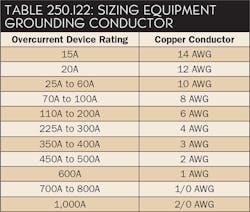Q. What are the rules in sizing equipment grounding conductors?
A. Equipment grounding conductors (EGCs) of the wire type must be sized not smaller than shown in Table 250.122, based on the rating of the circuit overcurrent device; however, the circuit EGC isn’t required to be larger than the circuit conductors [250.122(A)].
If ungrounded conductors are increased in size from the minimum ampacity that would be required for the load, wire type EGCs must be proportionately increased in size according to the circular mil area of the ungrounded conductors [250.122(B)]. Ungrounded conductors are sometimes increased in size to accommodate conductor voltage drop, harmonic current heating, short circuit rating, or simply for future capacity.
Let’s run through an example problem to clarify these requirements.
If the ungrounded conductors for a 40A circuit (with 75°C terminals) are increased in size from 8 AWG to 6 AWG due to voltage drop, the circuit EGC must be increased in size from 10 AWG to _____.
Let’s run through one more example problem.
If the ungrounded conductors for a 40A circuit (with 60°C terminals) are increased in size from 8 AWG to 6 AWG due to having four current-carrying conductors in a raceway, then the circuit EGC must be increased in size from 10 AWG to _____.
The EGC doesn’t need to be increased in size in this example, because the 6 AWG is the smallest size ungrounded conductor allowed by the Code.
8 AWG rated 40A at 60°C × 0.80 = 32A after adjustment factors is too small for the circuit example. 6 AWG rated 55A at 60°C is required (55A × 0.80 = 44A).
When multiple circuits are installed in the same raceway, cable, or cable tray, one EGC sized in accordance with Sec. 250.122, based on the rating of the largest circuit overcurrent device is sufficient [250.122(C)].
For motor branch circuits, the EGC of the wire type must be sized in accordance with Table 250.122, based on the rating of the motor circuit branch circuit short circuit and ground fault overcurrent device [250.122(D)]. But this conductor isn’t required to be larger than the circuit conductors [250.122(D)(1)].
Let’s run through one more example problem.
What size EGC is required for a 2 hp, 230V, single-phase motor?
Step 1: Determine the branch-circuit conductor size [430.22(A) and Table 310.15(B)(16)] 2 hp, 230V Motor FLC = 12A [Table 430.248]
12A × 1.25 = 15A, 14 AWG, rated 15A at 60°C [Table 310.15(B)(16)]
Step 2: Determine the branch circuit protection [240.6(A), 430.52(C)(1), and Table 430.248]
12A × 2.50 = 30A
Step 3: The circuit EGC must be sized to the 30A overcurrent device — 10 AWG [Table 250.122], but it’s not required to be sized larger than the circuit conductors — 14 AWG.
If circuit conductors are installed in parallel in separate raceways or cable as permitted by Sec. 310.10(H), then an EGC must be installed for each parallel conductor set [250.122(F)]. The EGC in each raceway or cable must be sized in accordance with Table 250.122, based on the rating of the circuit overcurrent device, but it’s not required to be larger than the circuit conductors [250.122(A)].
EGCs for feeder taps must be sized in accordance with Table 250.122, based on the ampere rating of the overcurrent device ahead of the feeder, but in no case is it required to be larger than the feeder tap conductors [250.122(G)].
Holt is the owner of Mike Holt Enterprises, Inc. in Leesburg, Fla. He can be reached at www.mikeholt.com.
About the Author

Mike Holt
Mike Holt is the owner of Mike Holt Enterprises (www.MikeHolt.com), one of the largest electrical publishers in the United States. He earned a master's degree in the Business Administration Program (MBA) from the University of Miami. He earned his reputation as a National Electrical Code (NEC) expert by working his way up through the electrical trade. Formally a construction editor for two different trade publications, Mike started his career as an apprentice electrician and eventually became a master electrician, an electrical inspector, a contractor, and an educator. Mike has taught more than 1,000 classes on 30 different electrical-related subjects — ranging from alarm installations to exam preparation and voltage drop calculations. He continues to produce seminars, videos, books, and online training for the trade as well as contribute monthly Code content to EC&M magazine.

